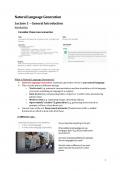Zusammenfassung
Summary- Natural Language Generation (INFOMNLG)
- Kurs
- Hochschule
This document includes a summary of all lectures, lecture notes, screenshots of important lecture slides and extra notes to help understand the contents and concepts better.
[ Mehr anzeigen ]



